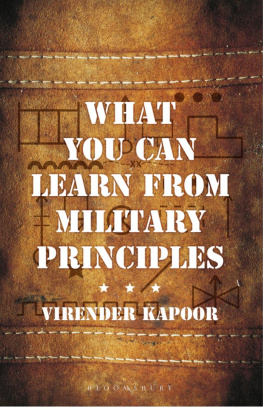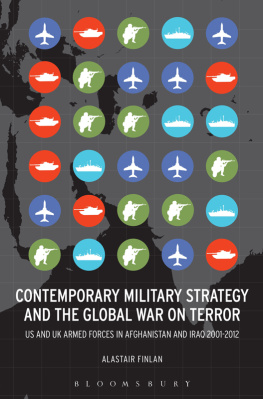MILITARY STRATEGY
PRINCIPLES, PRACTICES,
AND HISTORICAL PERSPECTIVES
Also by John M. Collins
Military Geography: For Professionals and the Public
Special Operations Forces
Americas Small Wars
Military Space Forces
Green Berets, SEALs, and Spetsnaz
U.S.Soviet Military Balance, 19801985
U.S. Defense Planning: A Critique
U.S.Soviet Military Balance, 19601980
American and Soviet Military Trends
Imbalance of Power (with Anthony Cordesman)
Grand Strategy: Principles and Practices
MILITARY STRATEGY
PRINCIPLES, PRACTICES,
AND HISTORICAL PERSPECTIVES
John M. Collins
With a Foreword by
Gnral Robert C. Kingston, USA (Ret.)

Copyright 2002 by Potomac Books, Inc.
Published in the United States by Potomac Books , Inc. All rights reserved. No part of this book may be reproduced
in any manner whatsoever without written permission from the publisher, except in the case of brief
quotations embodied in critical articles and reviews.
Maps by Jay Karamales.
Library of Congress CataloginginPublication Data
Collins, John M., 1921
Military Strategy: Principles, Practices, and Historical Perspectives / John M. Collins; with a foreword by
Robert C. Kingston.1st ed.
p. cm.
Includes Index.
ISBN 1574884301 (alk. paper)
1. Strategy. I. Title.
U162.C643 2002
355.03dc21
2001037843
Printed in the United States of America on acidfree paper that meets the American National Standards
Institute Z3948 Standard.
Potomac Books, Inc.
22841 Quicksilver Drive
Dulles, Virginia 20166
First Edition
1 0 9 8 7 6 5 4 3 2
To
Successive Commandants of the National War College
196873
Lieutenant Gnral John E. Kelly, United States Army,
who changed all my life goals as I neared age fifty,
when he made me Director of Military Strategy Studies,
and
Lieutenant Gnral John B. McPherson, United States Air Force,
who thereafter directed me to organize and serve as
Chief of a politicomilitary Strategic Research Group.
Contents
Figures
Tables
Maps
3. Bosnian Boundaries
Prescribed by the Dayton Peace Agreement, 1995
Foreword
Stars fell on the National War College Class of 1969, of which I was a member; John Collins was my faculty adviser. Five out of seventyfour lieutenant colonels and naval commanders eventually reached fourstar rank. Two became combatant commanders in chief, another was SHAPES Chief of Staff, then Deputy Commander. Four military students and one faculty member became lieutenant Gnrals or vice admirals. Nearly twenty more graduates wore one or two stars before they retired.
All were experienced tacticians and most knew a lot about operational art in 1968, but military strategy formulation Gnrally was a foreign field. The National War College unfortunately did little to correct that deficiency, despite a mission statement that promised to prepare students for the exercise of joint and combined highlevel policy, command and staff functions and for the planning of national strategy. The brief strategy course lacked a text. The only book that every student was obligated to read from cover to cover was Bernard Brodies 1959 treatise, Strategy in the Missile Age, which investigated a small sliver of the conflict spectrum. Supplemental readings barely scratched the surface of other important subjects, and few stressed fundamentals.
What the Class of 1969 needed most was a comprehensive textbook like Military Strategy. The chapter on coalition warfare strategies would have helped me immensely before I took charge of the Rapid Deployment Joint Task Force in 1981 and subsequently became the first Commander in Chief of U.S. Central Command, which included nineteen Southwest Asian and Northeast African countries within its Area of Responsibility. Distinctions between net assessments and threat assessments, the value of strategic centers of gravity, tradeoffs between military and nonmilitary power, and principles of military preparedness are just a few of the many topics that could have provided everybody with a better education than we actually received. I particularly like the intervention checklist that concludes . Armed with such insights, I could have participated more effectively in the JCS tank during debates about strategic courses of action and explained complex matters more easily in testimony before Congress.
This compendium, which I read in draft, reached print three decades too late to benefit the National War College Class of 1969, but twentyfirst century students of military strategy in the United States and abroad should benefit immensely from the vast array of intellectual tools between its covers. Politico-Military problem solvers who use the following pages as litmus papers to test options before they reach decisions should make fewer strategic mistakes than predecessors who, by and large, lacked ready references for such purposes.
Gnral Robert C. Kingston
United States Army (Retired)
Acknowledgments
The thirtytwoyear gestation of this document began in 1969, when Lieutenant Gnral John E. Kelly, thenCommandant of the National War College (NWC), told me, You are now Director of Military Strategy Studies. My response was, Sir, I cant even spell strategy, to which he replied, Neither can anyone else. Go make a name for yourself.
The 1969 NWC military strategy syllabus was my first stab, followed by a primer entitled Strategy for Beginners, which received nine rejection slips before the Naval Institute Press published it in 1973 as Grand Strategy: Principles and Practices. That book has been out of print for more than two decades but, with the publishers permission, I have clipped, reshuffled, and repasted many snippets herein, along with extracts from some of my other writings that first saw light as Congressional Research Service (CRS) issue briefs and reports.
My appreciation for military strategy has improved somewhat since 1973, but not nearly enough to write a book on that subject without professional help from assorted authorities who could, without compassion, critique the table of contents and every draft chapter before publication. I therefore sought and received invaluable insights from many knowledgeable individuals whose relevant experience ranged from no less than fifteen to more than thirty years. Each received the following guidance: Please tell me what is wrong, what you would add, and what you would subtract. Did you easily find your way from Point A to Points B, C, and D, or does the sequence require adjustment? Is the writing clear? Are there too many endnotes or not enough? Can you recommend better sources to cite? Be brutally frank, because Id rather hear bad news before rather than after publication.
Correspondence from five fourstar U.S. officers expressed strong support for the project at its onset in the summer of 1998: Gnral Henry H. Shelton, Chairman of the Joint Chiefs of Staff; Gnral Dennis J. Reimer, Army Chief of Staff; Admiral Jay L. Johnson, Chief of Naval Operations; Gnral Michael E. Ryan, Air Force Chief of Staff; and Gnral Charles C. Krulak, Commandant of the Marine Corps. Each designated a contact to represent his interests.











